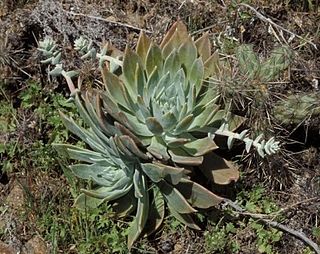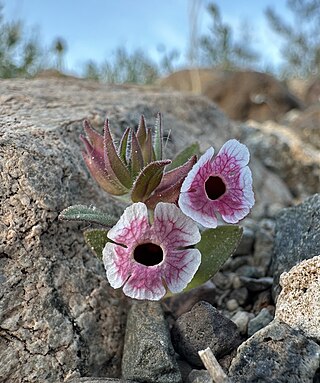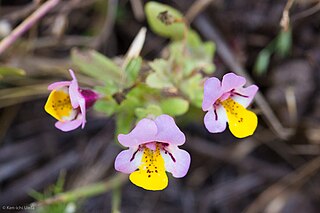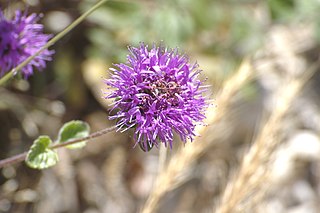
Dudleya traskiae is a rare succulent plant known by the common name Santa Barbara Island liveforever. This Dudleya is endemic to Santa Barbara Island, one of the Channel Islands of California, where it grows on rocky bluffs. The plant has a basal rosette of flat, spade-shaped fleshy leaves up to 15 centimeters long, which are pale green to yellowish. It erects tall stems bearing dense, rounded inflorescences of many bright yellow flowers.

Diplacus angustatus is a species of monkeyflower known by the common names purplelip pansy monkeyflower and narrowleaf pansy monkeyflower.

Diplacus clevelandii is an uncommon species of monkeyflower known by the common name Cleveland's bush monkeyflower. It was formerly known as Mimulus clevelandii.

Diplacus fremontii is a species of monkeyflower known by the common name Frémont's monkeyflower. It is native to California and Baja California, where it grows in mountain and desert habitat, especially moist or disturbed areas. It was formerly known as Mimulus fremontii.

Diplacus jepsonii, formerly classified as Mimulus nanus var. jepsonii, is a species of monkeyflower known by the common name Jepson's monkeyflower.

Diplacus johnstonii is a species of monkeyflower known by the common name Johnston's monkeyflower.

Diplacus layneae is a species of monkeyflower known by the common name Layne's monkeyflower. It is an annual herb that is endemic to California.

Diplacus leptaleus is a species of monkeyflower known by the common name slender monkeyflower.

Diplacus mephiticus is a species of monkeyflower known by the common names skunky monkeyflower and foul odor monkeyflower. It was formerly known as Mimulus mephiticus.

Diplacus mohavensis is a species of monkeyflower known by the common name Mojave monkeyflower.

Diplacus nanus is a species of monkeyflower known by the common name dwarf purple monkeyflower. It is native to California and the Northwestern United States to Montana. It grows in moist habitat, often in bare or disturbed soils. It was formerly known as Mimulus nanus.

Diplacus pictus is a species of monkeyflower known by the common name calico monkeyflower.

Diplacus pulchellus is an uncommon species of monkeyflower known by the common name yellowlip pansy monkeyflower. It was formerly known as Mimulus pulchellus.

Mimulus ringens is a species of monkeyflower known by the common names Allegheny monkeyflower and square-stemmed monkeyflower.

Diplacus torreyi is a species of monkeyflower known by the common name Torrey's monkeyflower.

Diplacus tricolor is a species of monkeyflower known by the common name tricolor monkeyflower. It is native to Oregon and California. It grows in seasonally wet habitats such as meadows and vernal pools, including those in the San Joaquin Valley and near north coast oak woodlands. It was formerly known as Mimulus tricolor.

Diplacus viscidus is a species of monkeyflower known by the common name sticky monkeyflower.

Diplacus bicolor is a species of monkeyflower known by the common name Harlequin monkeyflower. It is also known as Diplacus whitneyi.

Monardella undulata is an uncommon species of flowering plant in the mint family known by the common name curlyleaf monardella. It is an annual herb and is endemic to the coast of California.

Diplacus puniceus, commonly known as the red bush monkeyflower, San Diego monkey flower, or mission diplacus, is a species of perennial shrub native to coastal southern California and northern Baja California. It is characterized by a relatively small and broad corolla for Diplacus, a lack of glandular hairs, and dark orange or red flowers, adapted to hummingbird pollinators.




















